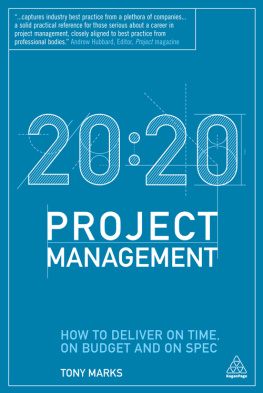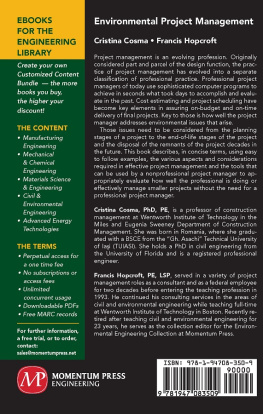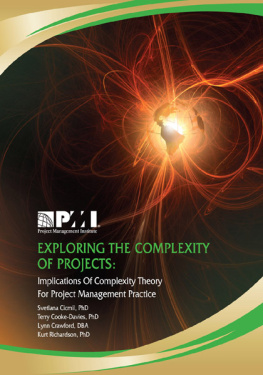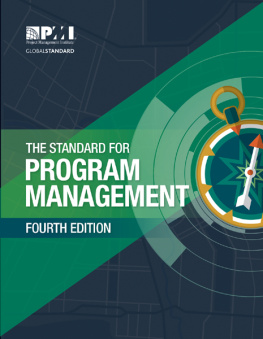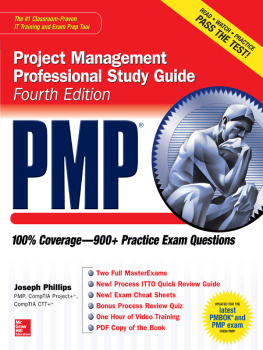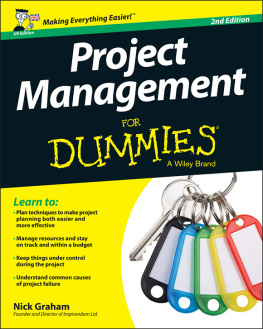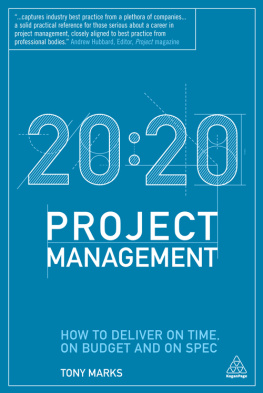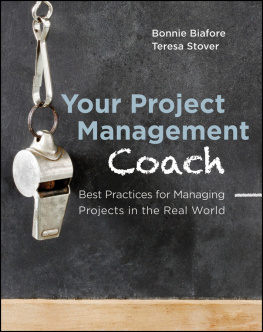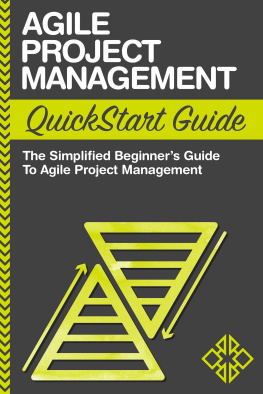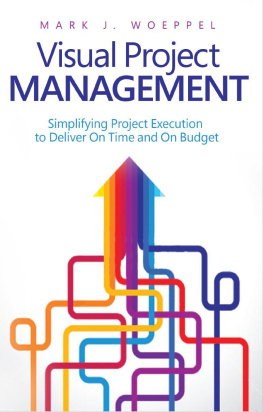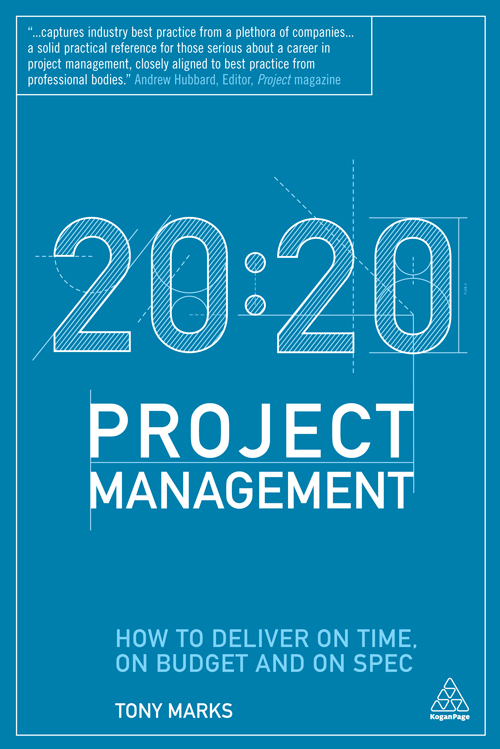Note on the Ebook Edition For an optimal reading experience, please view large
tables and figures in landscape mode. |
This ebook published in 2012 by
Kogan Page Limited
120 Pentonville Road
London N1 9JN
UK
www.koganpage.com
Tony Marks, 2012
E-ISBN 978 0 7494 6609 1
Contents
T his book is the culmination of nearly 30 years of project management in practice, with 12 of those years consulting and teaching in some of the worlds leading organizations. Inevitably this means that much of the theory and experience contained in this book have come from learning from other peoples successes and failures. Much has also been drawn from the professional bodies that have helped collate best practice in project management. These people are too numerous to mention but there are a number of people who have made specific and valued contributions to this book.
First and foremost I would like to thank Graham Chapman, with whom I co-founded 20|20 Business Group eight years ago. A lifelong friend and colleague, Graham has contributed most towards the content of this book. I know of no better project management facilitator and Graham has travelled the world teaching best practice to a wide range of organizations, especially in the energy sector. His knowledge of project management, and especially project teams and leadership, has been invaluable in helping with this book. Amongst my colleagues at 20|20, Dave Gilbert, Jim Littlefair and Pete Walters have helped to edit the text, and Tomas Havlik has painstakingly helped ready the manuscripts for publication.
The case studies are an invaluable part of this book, providing the reader with examples of the practical application of theory, tools and techniques. I would like to thank Iain Sutherland of Talisman Energy (Canada), Craig MacFarlane from Subsea 7 (Norway), Bob Davidson from Halliburton (UK and USA), Shane Forth and Neil Atkinson from AMEC (UK), Alan Baxter and Orlando Ovalles from Wood Group PSN (Global), Dave Phillips and Doug Wilson from Mott MacDonald (Global) for their significant contributions. All of these contributors have busy project roles and have taken time out to help with this book.
I would also like to thank Mick Cope of Wizoz for encouraging me for too many years to write this book and Liz Gooster, editor-at-large with Kogan Page for encouraging me to stick to my project plan! I delivered on spec, on budget and nearly on time. But those are the compromises of project management in the real world.
Finally I would like to thank my wife, Alison, who has supported me throughout my life in project management.
This book is organized for the readers convenience to follow a project life cycle. This is for two purposes:
- Whilst the reader may read the book from cover to cover before embarking on a project initially, it is envisaged that each chapter can then be read and absorbed in more detail before a particular phase of the project life cycle commences.
- The author recognizes that some project managers may have taken over a project part of the way through the project life cycle. It is therefore useful to be able, for reference, to go directly to the relevant chapter(s).
The book is also organized into two main sections:
- Chapters that follow the project life cycle (Starting your project, Defining your project, Planning your project, Executing your project).
- Chapters that are relevant or useful throughout the project life cycle (Risk and your project, Estimating your project, Project leadership, Teams and your project, and the Glossary of terms).
Each chapter is also divided into subsections as follows:
- Introduction;
- Best practice;
- Things to consider;
- Conclusion;
- Case study.
Finally, there is a continuously updated online resource available at www.2020projectmanagement.com to provide further case studies, white papers, project management templates, discussion forums, useful links and details of useful supporting services.
Tony Marks is the Chief Executive of 20:20 Business Insight, the UKs largest specialist Project Management Training and Consultancy company, with offices in Scotland, England, the United States and the Czech Republic and partners in Scandinavia, West Africa and the Middle East. He has 30 years experience in project management delivering high value projects, consulting and teaching in a wide range of sectors including utilities, nuclear, oil and gas, engineering, construction, IT and telecoms.
Tony is accredited by all three professional bodies including The Project Management Institute (PMI)s Project Management Professional credential, The Association for Project Management (APM)s APM Professional, and The APM Groups Prince 2 Practitioner. He is also a Fellow of The Association for Project Management (The UK body of an international association covering 55 countries), a Fellow of The Chartered Management Institute, a Fellow of The Institute for Leadership Management, and a member of The Project Management Institute. Tony also holds an MBA majoring in Project Management Systems and Administration.
Tony is a lecturer and examiner for The University of Aberdeen on their MSc in Project Management course. He has written the Project Management Handbook for NHS Capital Projects and edited Project Management Handbooks for a number of commercial companies. He lives in Scotland but travels extensively.
Operations keeps the lights on, strategy provides a light at the end of the tunnel, but project management is the train engine that moves the organization forward.
JOY GUMZ
T his chapter sets the scene regarding some of the fundamentals to a successful project, some of which will be discussed in greater detail in later chapters.
The following sections of this chapter discuss the basics of projects, project management and the project management process.
Projects come in many guises from major engineering projects such as shipbuilding, aerospace and oil and gas production to small changes to existing company processes. However wide-ranging in size, projects will all have the same common attributes.
Project management and projects are defined by the UKs Association for Project Management as:
the process by which projects are defined, planned, monitored, controlled and delivered such that the agreed benefits are realized. Projects are unique transient endeavours undertaken to achieve a desired outcome. Projects bring about change and project management is recognized as the most efficient way of managing such change.
Projects almost always have the following characteristics:
- clear objective(s);
- constraints of cost, quality and time;
- a fixed timescale;
- a fixed budget;
- a team of people;
- little practice or rehearsal;
- change and uncertainty;
- uniqueness.
Even if similar projects have been conducted several times they will still follow the characteristics defined above and the uniqueness of a project may come from one of the following:
- a new team of people;
- a new customer/client;
- a different budget;
- new technology;
- a different timescale;
- a different objective;
- a different location;
- different working conditions.
What is the purpose of a project?
The purpose of a project is to produce a unique product or service that will deliver some benefit or purpose.

